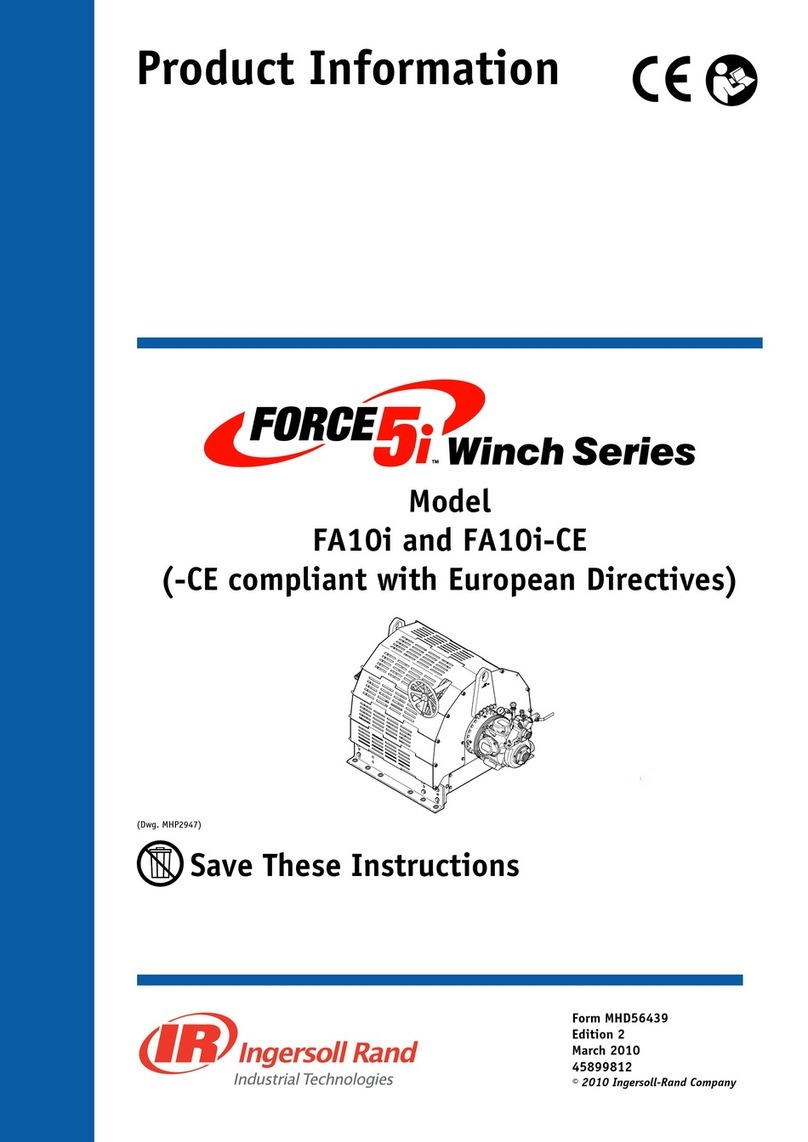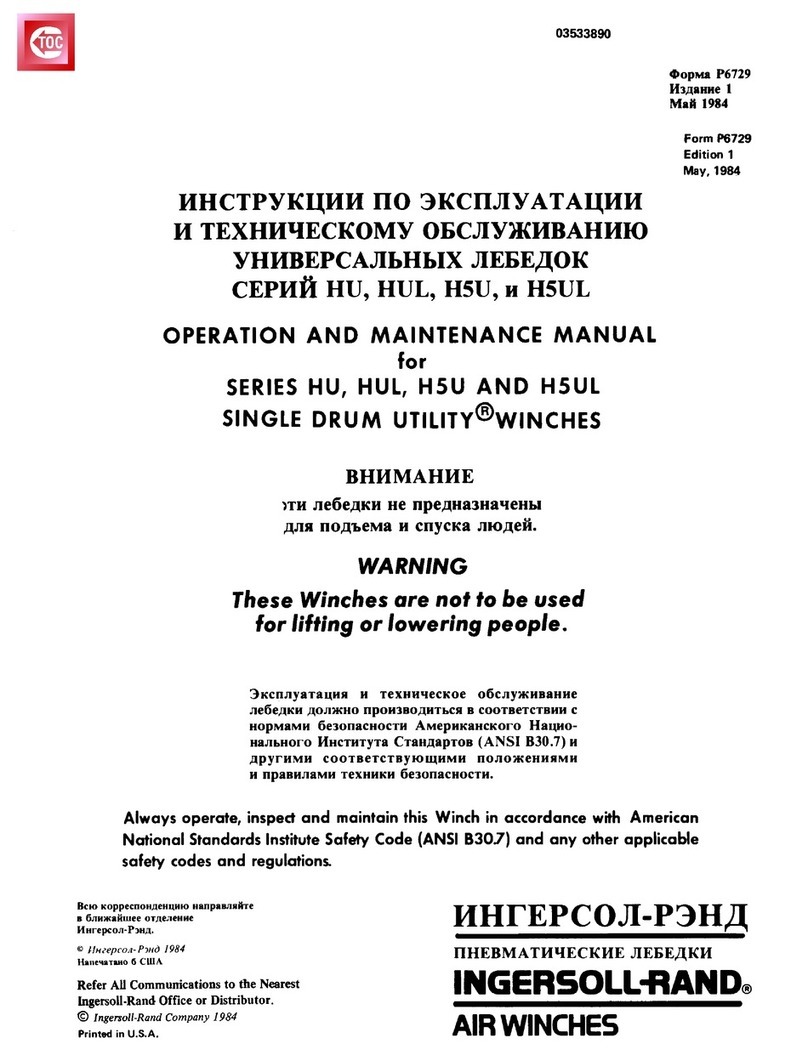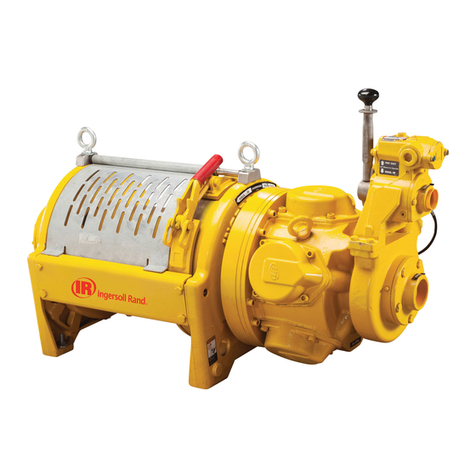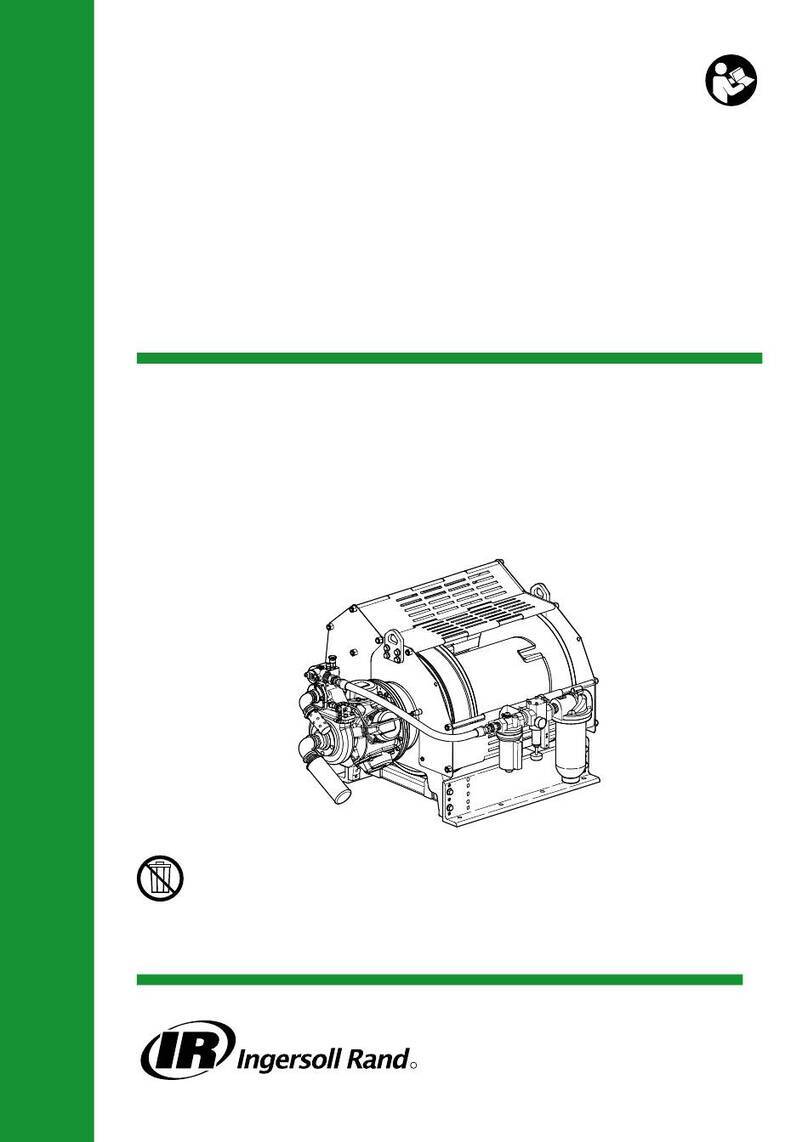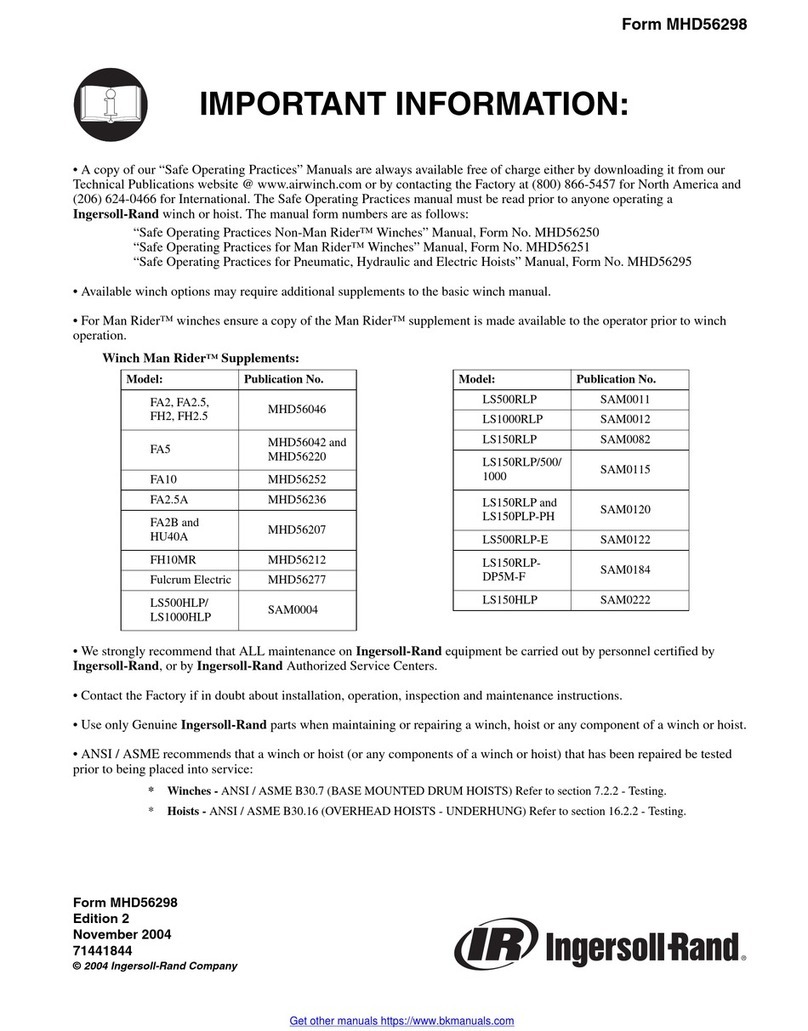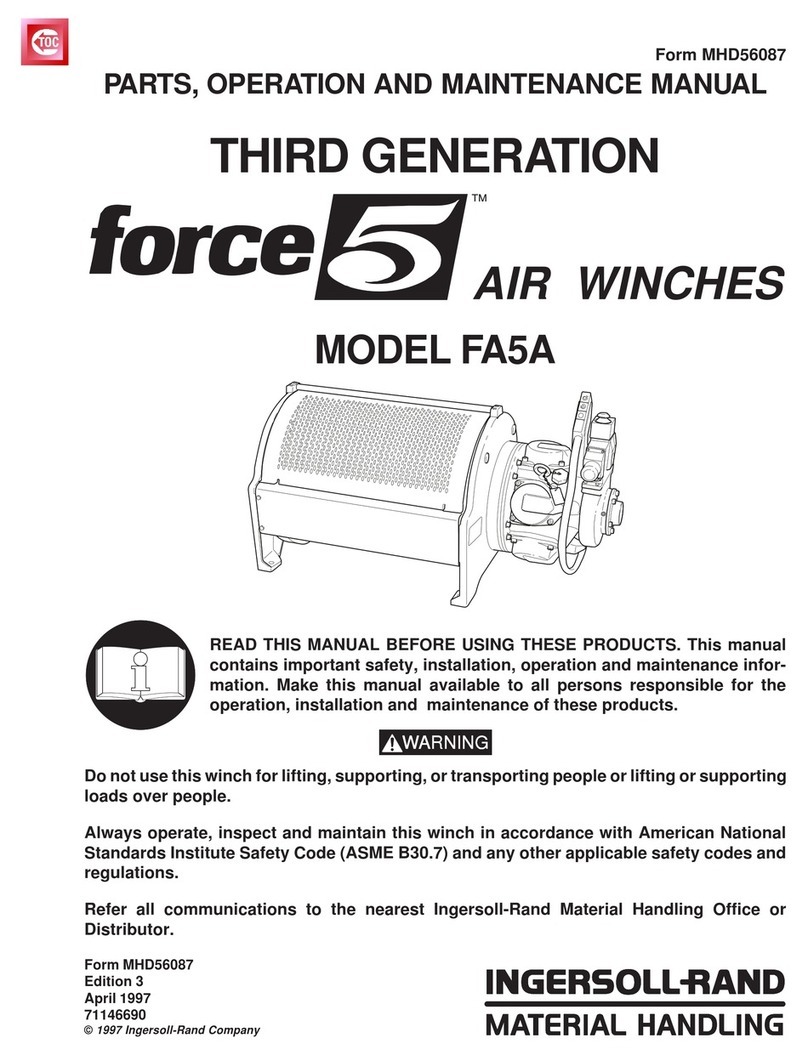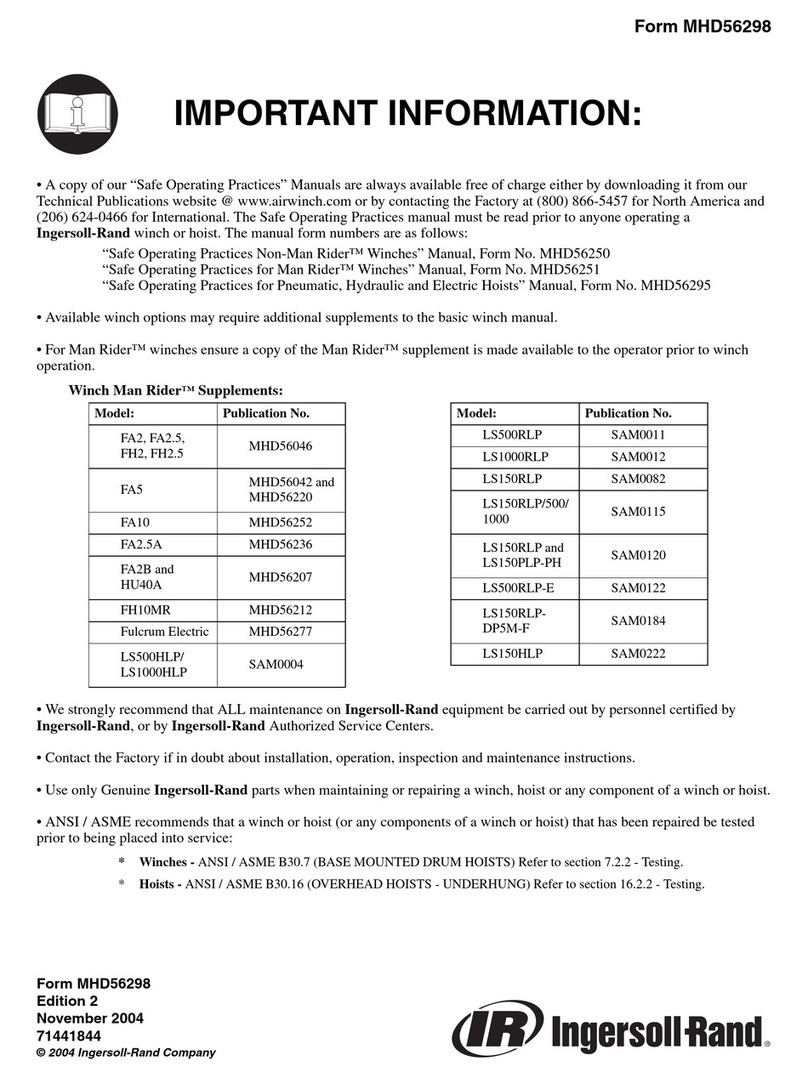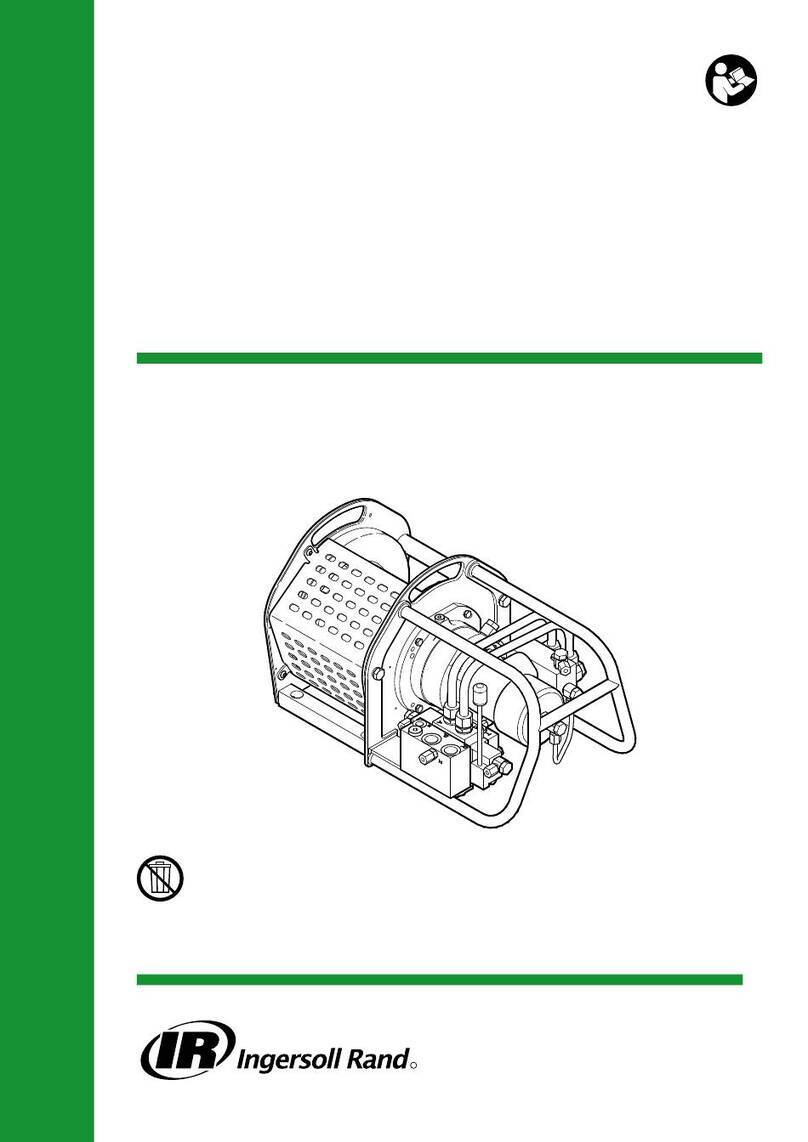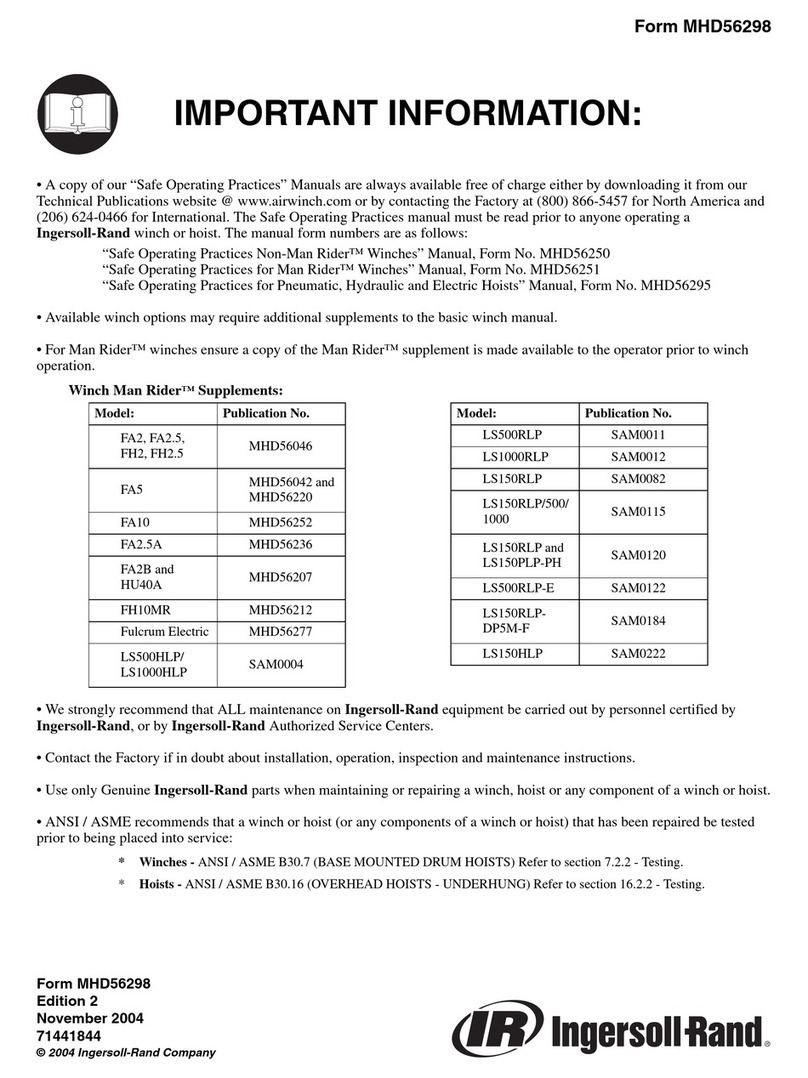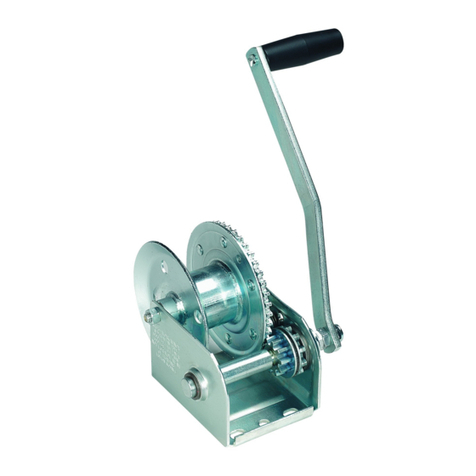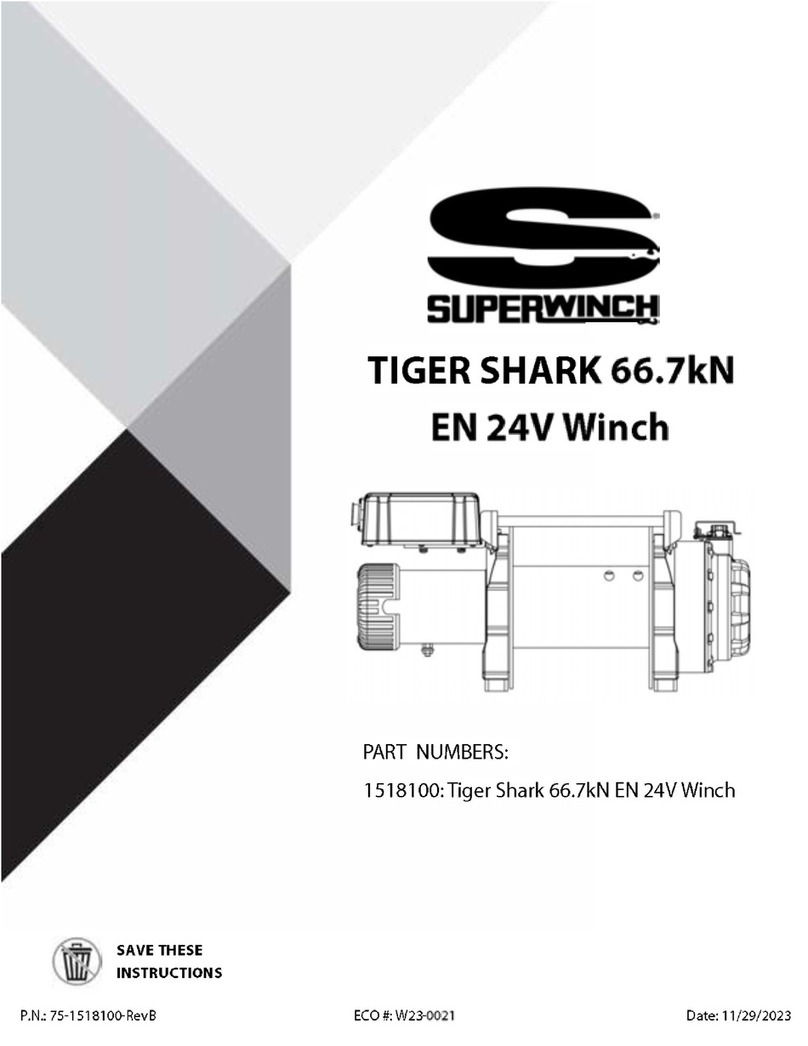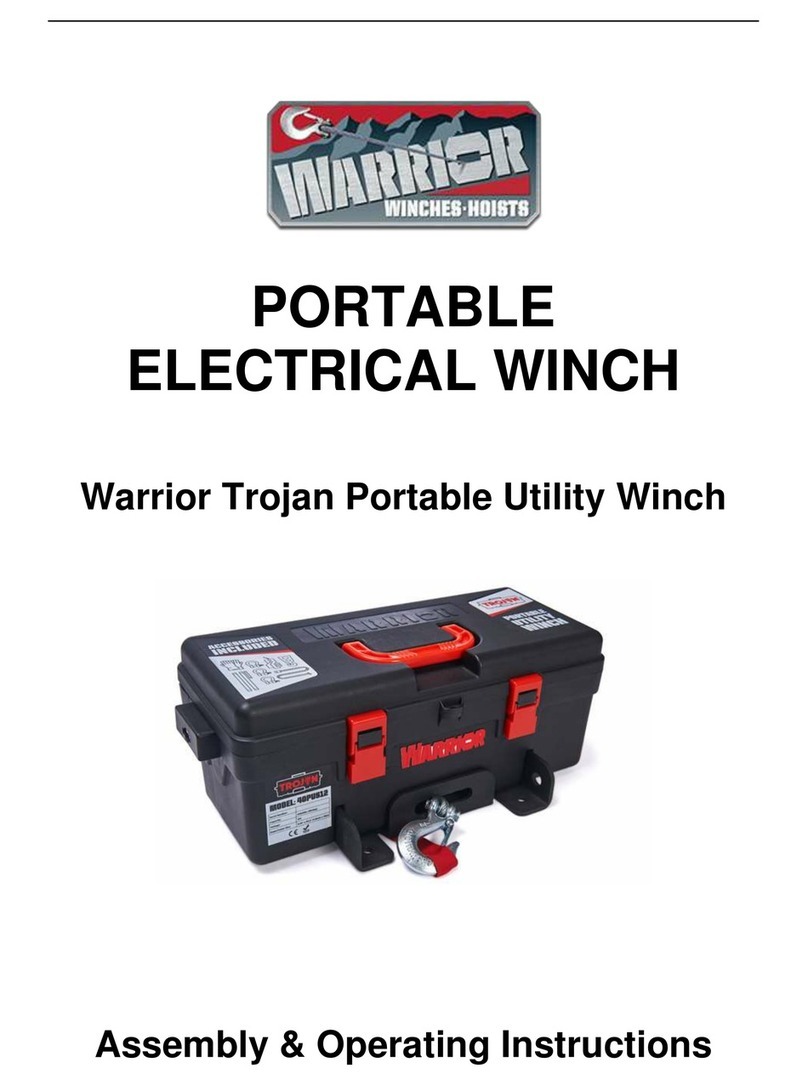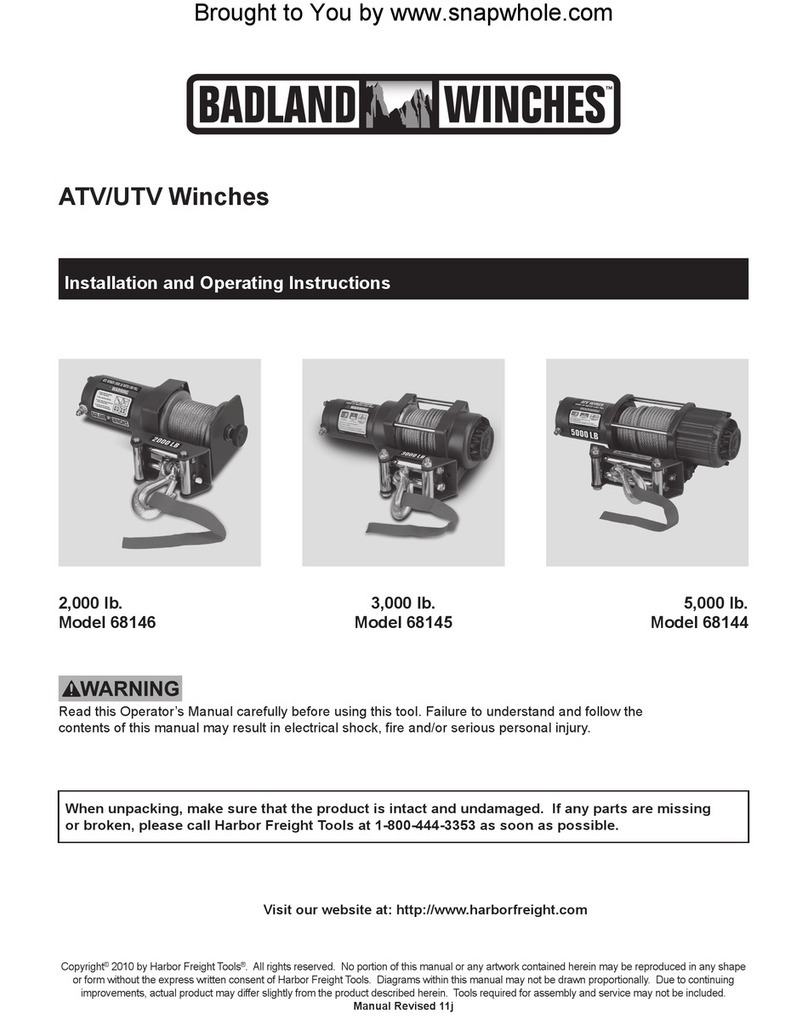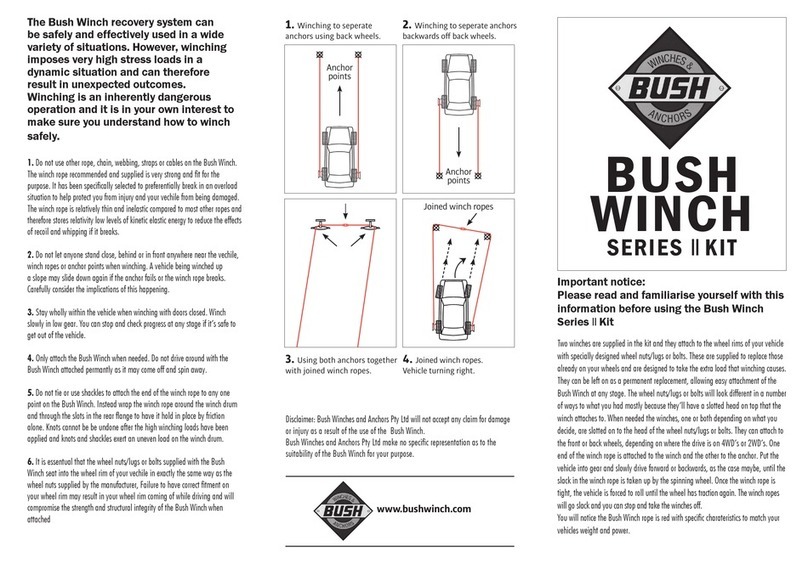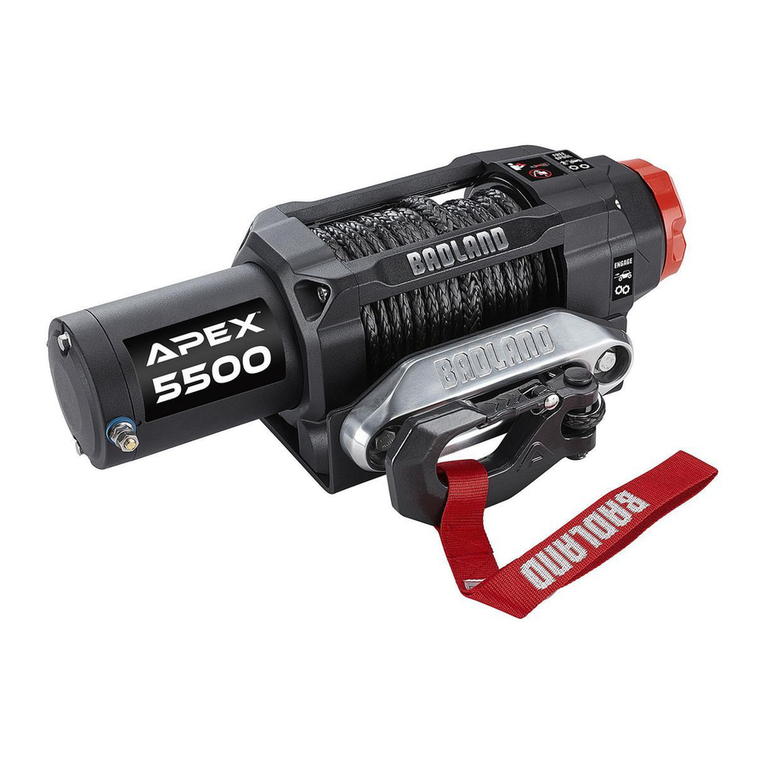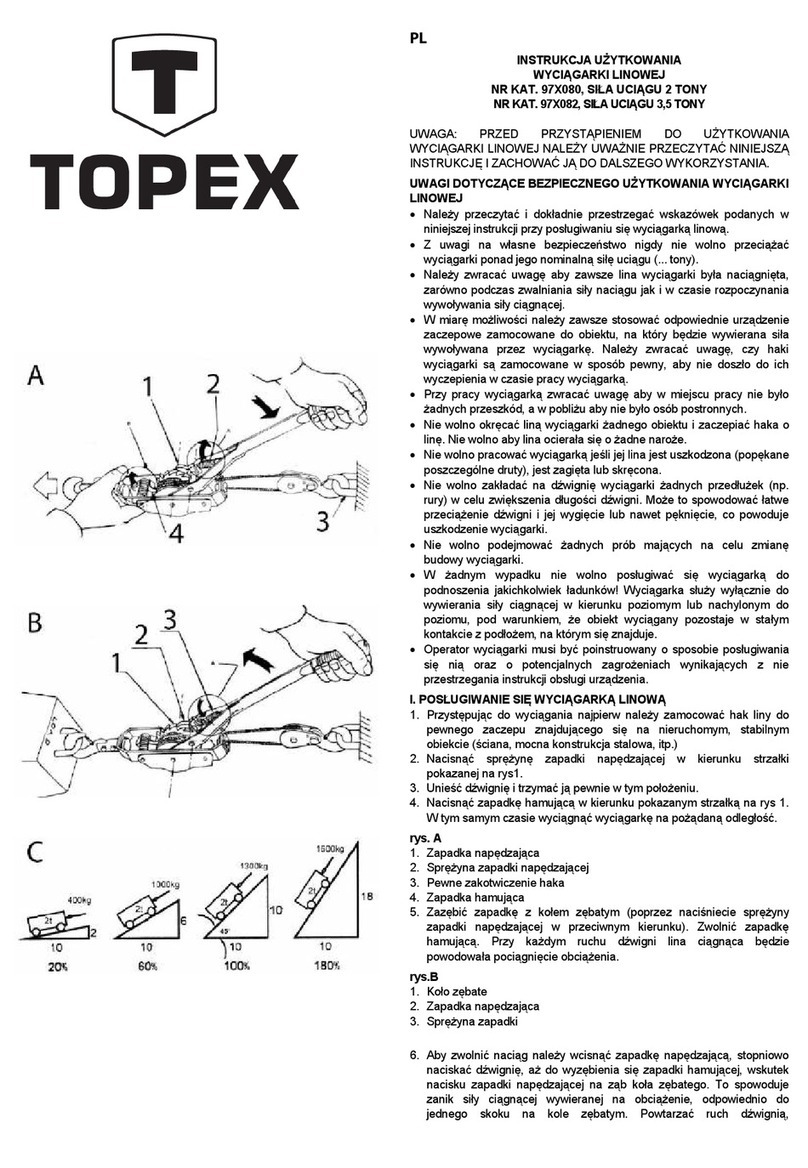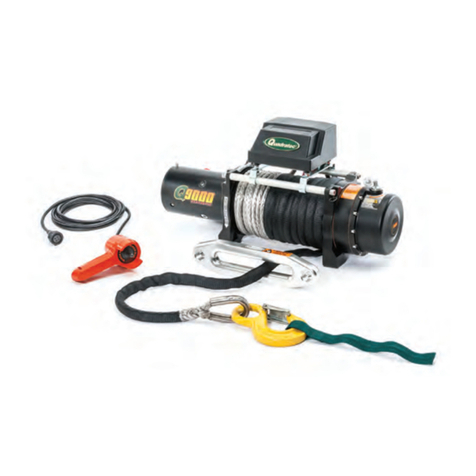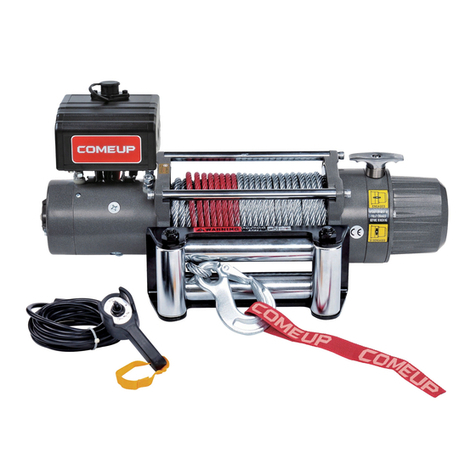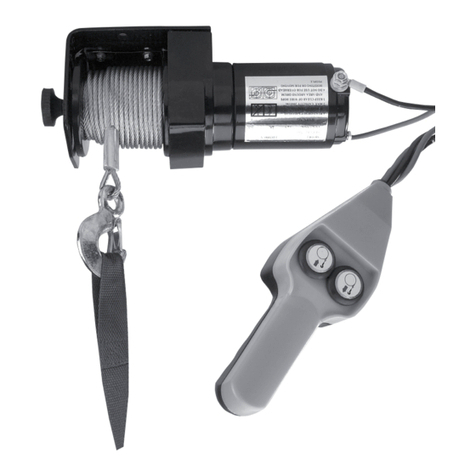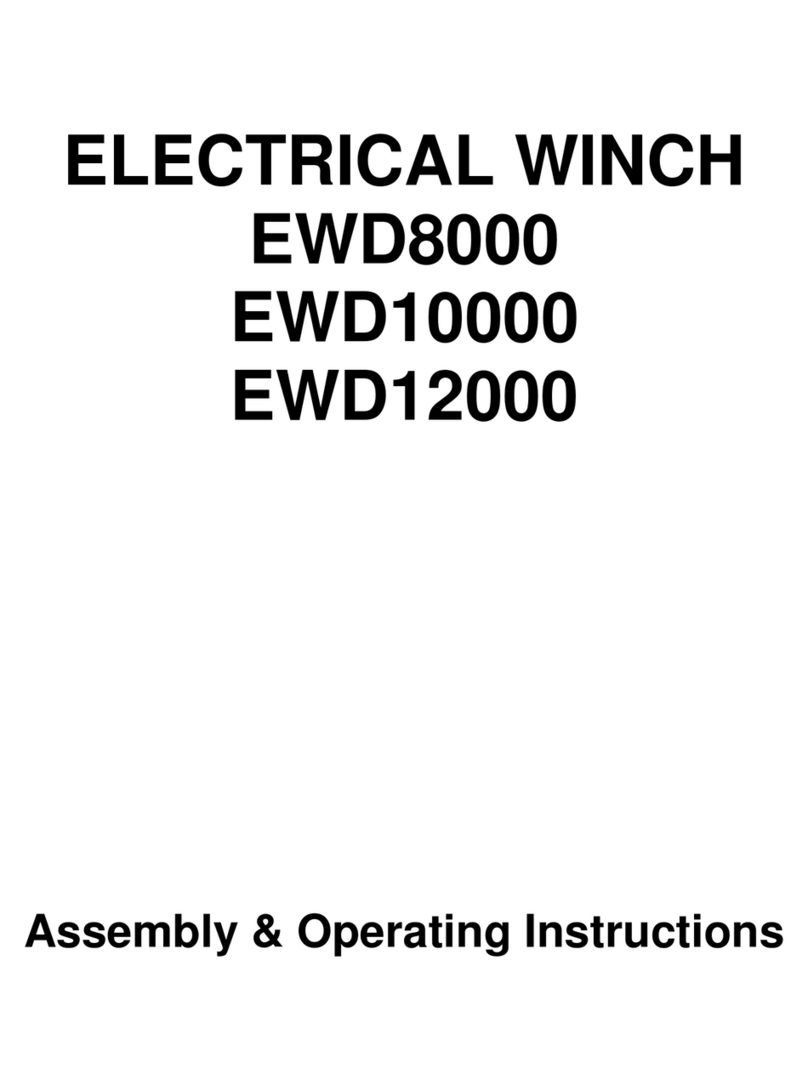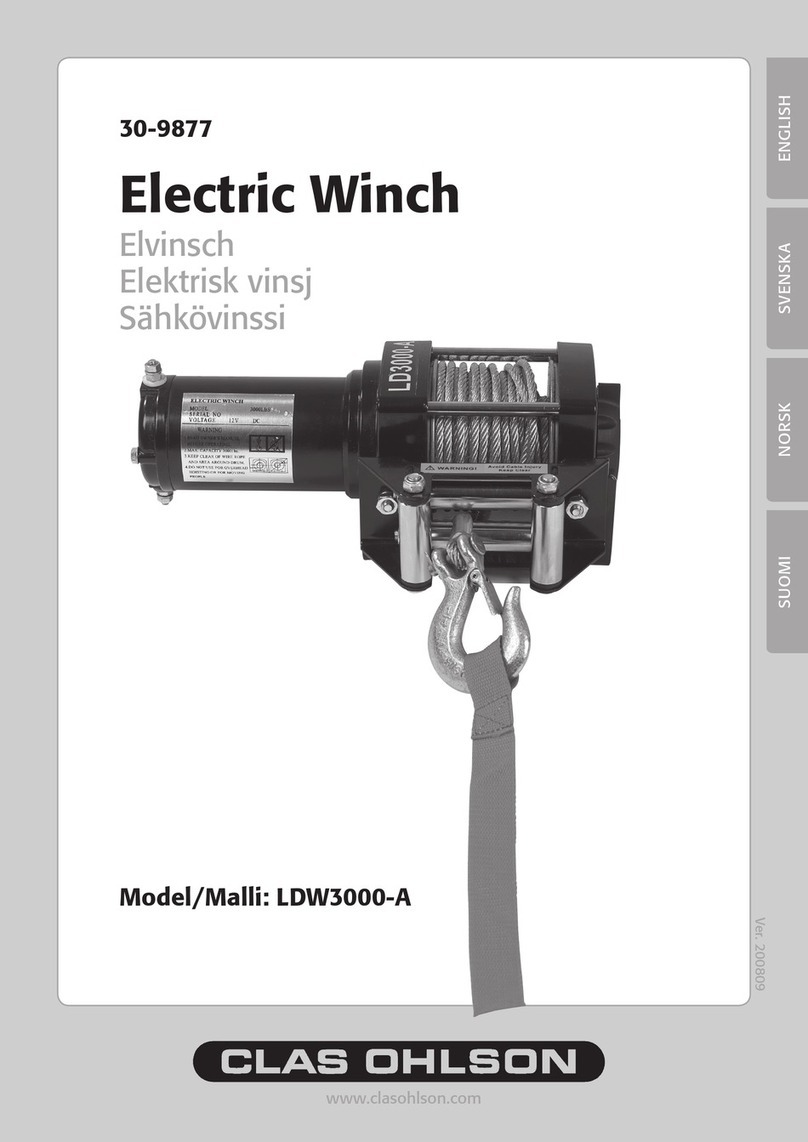
Setting with test load:
Actuate auxiliary valve to TENSIONING position. Winch should operate, causing load
line to become taut. To increase tension, rotate regulator knob clockwise until load
beginsto rise.Rotateregulatorknobcounterclockwiseaminimumof1/4 turn,or until
load is balanced (does not raise or lower). Note pressure indicated on gauge for
future setting reference.
Setting with scale:
Actuate auxiliary valve to TENSIONING position. Winch should operate, causing load
line to become taut. To increase tension, rotate regulator knob clockwise until scale
indicates desired tension. Note pressure indicated on gauge for future setting
reference.
nGuideline System - Regulator Adjustment
Refer to Dwg. MHP2940.
The regulator (794) on bracket (791) is factory preset at approximately 50 psig (3.5
bar/349 kPa) to maintain tension of 4500 lbs (2045 kg) on load line. To change this
preset for specific load applications, regulator pressure may be adjusted to increase
or decrease tension setting.
WARNING
• When adjusting regulator, ensure winch control lever is locked in neutral
position and guideline selector lever is in the NORMAL position.
• Winch supply air is NOT turned off during regulator adjustments. To
prevent accidental winch operation, allow only a single person, trained in
operation, safety and maintenance of this product, to conduct regulator
adjustments.
Regulator Adjustment Procedure:
1. Remove valve handle ball (770).
2. Remove cover (766).
3. Loosen jam nut on regulator (794). Refer to Dwg. MHP1175 on page 7, A.
Regulator; B. Jam Nut; C. Adjustment Screw.
WARNING
• Ensure slack load line is taken up by operating winch control valve with
selector in NORMAL position. If selector lever is placed in GUIDELINE
position the winch will immediately attempt to establish line tension
causing line to ‘snap’ resulting in injury or damage to property.
Regulator (794) Adjustment:
A
B
C
Regulator
Adjustment
Screw Jam Nut
(Dwg. MHP1175)
4. Place selector lever into GUIDELINE position.
5. Observingpressure gauge(32), rotateregulator adjustmentscrew.RefertoDwg.
MHP1175 on page 8.
NOTICE
•Clockwiseturnsincreaseregulatorpressure resultinginincreased loadline
tension. Counterclockwise turns decrease regulator pressure resulting in
decreased load line tension.
6. Increase or decrease pressure setting in 5 psig (0.35bar/34 kPa) increments.
Allow winch to adjust to setting before proceeding. Repeat adjustment until
required tension is established.
CAUTION
•Continuous overhauling at regulator pressures equal to or greater than 70
psig (4.8 bar/483 kPa) may cause winch damage.
nDisassembly
nGeneral Disassembly Instructions
The following instructions provide necessary information to disassemble, inspect,
repair, and assemble product. Parts drawings are provided in Product Parts
Information Manual.
If a product is being completely disassembled for any reason, follow the order of
topics as they are presented. It is recommended that all maintenance work on
product be performed in a clean dust-free work area.
In the process of disassembling product, observe the following:
1. Never disassemble product any further than is necessary to accomplish needed
repair. A good part can be damaged during the course of disassembly.
2. Never use excessive force when removing parts. Tapping gently around
perimeter of a cover or housing with a soft hammer, for example, is sufficient to
break the seal.
3. Do not heat a part with a flame to free it for removal, unless part being heated
is already worn or damaged beyond repair and no additional damage will occur
to other parts.
In general, products are designed to permit easy disassembly and assembly. The
use of heat or excessive force should not be required.
4. Keep work area as clean as practical, to prevent dirt and other foreign matter
from getting into bearings or other moving parts.
5. All seals, gaskets and ‘O’ rings should be discarded once they have been
removed. New seals and ‘O’ rings should be used when assembling product.
6. When grasping a part in a vise, always use leather-covered or copper-covered
vise jaws to protect the surface of part and help prevent distortion. This is
particularly true of threaded members, machined surfaces and housings.
7. Donotremoveanypart whichisapressfit inoron asubassembly unlessremoval
of that part is necessary for repairs or replacement.
8. When removing ball bearings from shafts, it is best to use a bearing puller. When
removing bearings from housings, drive out bearing with a sleeve slightly
smaller than outside diameter of bearing. The end of sleeve or pipe which
contacts bearing must be square. Protect bearings from dirt by keeping them
wrapped in clean cloths.
nWinch Disassembly
Refer to Dwgs. MHP2693, MHP2937 and MHP2923.
1. Remove wire rope from drum.
2. Operate winch to position reduction gear drain plug at its lowest position.
3. Relieve pressure in air lines by operating winch control several times after air
supply has been turned off.
WARNING
•Shut off, bleed down and disconnect the air supply line before performing
any disassembly procedures.
4. Disconnect and tag air lines.
5. Remove winch from its mounting and take to a suitable work area before
beginning disassembly.
6. Remove lower case drain plug (225) on motor housing (217) and allow oil to
drain into a suitable container. Loosen vent cap (210) to vent motor housing.
7. Drain oil from reduction gear assembly by removing one plug (58) when
positioned at its lowest point, and one plug (58) from its highest point to vent.
Refer to Dwg. MHP0140 in Product Information Manual. If winch is equipped
with a band brake, elevate winch outboard end (opposite from motor end) to
prevent draining oil from contaminating brake band lining.
8. For winches with a disc brake, remove pipe plug (24) in brake housing (21) to
drain brake oil.
9. Remove band brake, winch guard and any other externally mounted winch
attachments.
10. Refer to ‘Winch Guard Disassembly’ on page 9.
a. Remove panels (805) and (807), one section at a time, by removing locknuts
(804) and crossbars (806).
b. Remove capscrews (182) and washers (48) securing lifting lugs (183) to
uprights.
c. Remove capscrews (809) and washers (96) securing guards (802), (801) and
(810) to uprights (42) and (184).
WARNING
• The air motor weighs approximately 260 lb. (118 kg). Adequately support
air motor before removing motor mounting capscrews.
11. Remove capscrews (4) and lockwashers (3) securing motor assembly to motor
adapter(6).Using a hoisttosupport motor,pullmotor straight awayfromwinch.
Reference the ‘Motor Disassembly’ on page 9 if motor disassembly is required.
Instructions 12 through 18 apply only to winches with a disc brake.
12. Alternately and evenly loosen eight capscrews (179) until brake spring
compression is relaxed. Remove capscrews and motor adapter (6).
13. Remove brake housing (21). If brake housing sticks, tap it with a soft-faced
hammer until parts separate.
14. Note position of all brake parts for reassembly.
15. Remove five friction plates (16) and six drive plates (17).
16. Remove springs (9) from brake piston (10).
17. Remove brake piston (10) from brake housing (21). Tap lightly with a plastic
mallet to separate parts, if necessary.
18. Remove seals (11) and (12) from brake piston (10).
19. Loosen capscrew in collar (13) and slide collar from drive shaft (35) with gear
(19).
20. Remove retainer ring (36) from bore of drum shaft (41).
21. Pull shaft and bearing assembly from drum shaft (41).
22. Support drum (96) and remove capscrews (39) from drum shaft (41). Pry drum
shaft (41) from inboard upright (42).
23. Remove capscrews (180) and lockwashers (178) that secure siderails (98) to
inboard upright (42). Drive out dowel pins (181).
24. Remove inboard upright (42).
25. Remove capscrews (196), lockwashers (306) and end cover (193) from outboard
upright (184).
26. Remove capscrews (192) and bearing retainer (191) from drum (96).
27. Remove drum and reduction gear assembly.
8Form MHD56398 Edition 3





